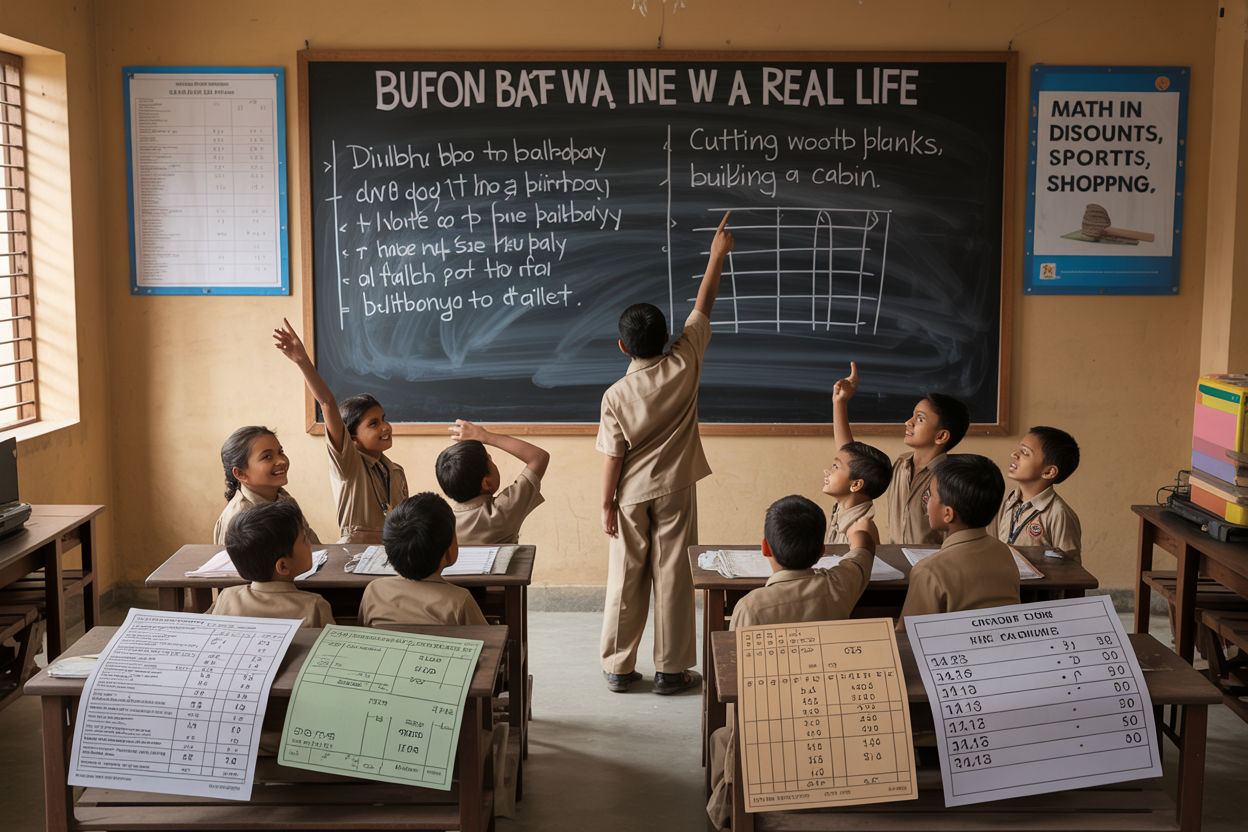- December 7, 2023
- by Educational Initiatives
- Blog
- 0 Comments
Last week while scrolling through my social media, I came across this post that had garnered thousands of likes and comments!

It clearly resonated with a large group of people and brought out a common distrust towards learning Mathematics compulsorily at school. The post made me realize that an entire generation of learners has grown up without a clear understanding of real-life application of Mathematics. Though many agree on the utility of learning arithmetic and foundational numeracy skills to succeed in life, it is a common view among masses that a lot of topics as they are redundant in today’s time. Personally, I concur with this thought and agree that Mathematics curriculum desperately needs an update to align to the needs of 21st century and prepare learners for the relevant skills needed to succeed. However, the importance of learning these topics should also not be overlooked. After all, mathematics equips us to understand and make sense of the natural phenomena around us. It is one of the most powerful tools to decode the mystery of scientific explorations around us. Then, why do they look redundant?
 click: https://www.youtube.com/watch?v=SjSHVDfXHQ4
click: https://www.youtube.com/watch?v=SjSHVDfXHQ4
The problem, in part, lies in the fact that learners are not posed with questions that allow them to visualize Math problems as “authentic” – something that makes sense in the real world and isn’t abstract.
Research (Palm, 2008) has verified that when it comes to Mathematics, learners tend to view the world as binary – one that is confined to their Math classroom and one that is outside of it. It is believed that tBecause we have been taught to always find an answer. That may be correct in the theoretical setting, but when we expect them to walk out of the classroom and apply their learnings in the real-world, the theoretical restrictions don’t apply any more.
A proven method has been to design Mathematics word problems that are authentic in their context (Greer, 1997). The more the learners encounter authentic questions in the classroom, the more they are likely to understand the use of Mathematical skills in the real-world.
What makes a question “authentic”?
Any authentic question in Mathematics generally has all or most of the following aspects in a balanced way.

Now, let’s look at the questions below –
Question 1: A grandfather gives his 4 grandchildren a box containing 18 balloons, which they share equally. How many balloons does each grandchild get?
Question 2: Anthony has bought 4 planks of 2.5 m each. How many planks of 1 m can he saw out of these planks?
Would you rate these questions as representative of authentic contexts? Do you think that they present realistic conditions? Most students who have learned multiplication and division would answer 4.5 balloons for question 1 and 10 planks for question 2. However, these are not the responses one would encounter in real-life. A grandfather would not be able to split a balloon in half to give his grandchildren, and neither would Anthony be able to create ten 1 m planks using planks that will result in half meter pieces.
Let’s reframe these questions and see the impact.
Question 1 (modified): You have a birthday party, and counting yourself, there are 4 children at the party. You receive a bag with 18 balloons from your grandfather. For no one to be sad, he wants you to share them equally so that each of the children gets the same number of balloons. How many balloons shall be given to each child?
Question 2 (modified): You are building a cabin and as walls you want to use planks that are 1 m long without any breaks. You are at the moment short of thirteen 1-meter planks. A friend says that she has found 4 planks, each 2.5 m long. You are wondering if that is enough to finish the walls. How many 1-meter planks can you saw out of the planks she found?
In the modified version, the event and the purpose are made explicitly clear to the learner. Along with that, all relevant data is provided to help them answer the question in a realistic manner. For question 1 (modified), the higher percentage of learners have been observed that each grandchild would get 4 balloons Similarly, for question 2 (modified), the learner is more likely to respond that only eight 1 m planks can be cut.
At Ei, we strive to apply these practices and frame questions that are rooted in the intent of ensuring that learners walk away with an explicit understanding of real-life applications of Mathematics. Some examples of using authentic context are shared below that have been designed by Ei.
- Permutations and Combinations

- Percentage
Sreya looks at the discounts offered by four different shops as shown below. Which shop should she visit to get EXACTLY 50% discount?

- Ordering of rational numbers

How do you make authentic questions?
Many educators find it difficult to come up with authentic contexts for their questions and end up using word problems that students have been doing mechanically over decades. Shared below are some ways that you can get started to make more authentic questions for your students.
- Add a purpose, include more relevant data and less distractions in the word problems to make them more authentic. For e.g. Question A given below can be converted to a more authentic question (B) to expect more authentic & realistic responses from students and help students connect math with real-life.
Question A
Martin’s best time to run 100 m is 10.00 sec. How long will it take him to run 10000 m?
Question B
There is an athletics competition on TV. You and a friend watch when the fastest man in the world, Maurice Green, wins the 100 m race in 10.00 sec. The next race you watch is 10000 m, which is won by Haile Gebrselassie in 26 min and 5 sec. What do you answer when your friend asks you: How long time do you think it would take Maurice Green to run 10000 m?
- Look for problems around you – Be it an electricity bill, a parking meter, a shopping mall, or a cricket field, one can find a variety of potential authentic questions that will allow students to start visualizing the need of using Mathematics. For e.g.

There are 10 rows and 480 people waiting to be seated. Will all the people be seated in the auditorium?
- Gather realistic and authentic data from many of the trusted websites, newspapers, magazines to create questions. Do not forget to cite the source of the data.

4. Explore online resources like Brilliant.org, Khan Academy, TED-Ed etc. to gather suggestions and ideas about authentic problems in Mathematics.
As a concluding exercise, I would request you to revisit some of the questions that you have either created or solved recently, and evaluate if those are helping the learner answer in a manner that aligns with the realistic contexts. In case they don’t, what changes would you make in those questions? Try it out and keep learning.
Bibliography
Palm, T. (2008). Impact of authenticity on sense making in word problem solving. Educ Stud Math, 37-58. doi:10.1007/s10649-007-9083-3



